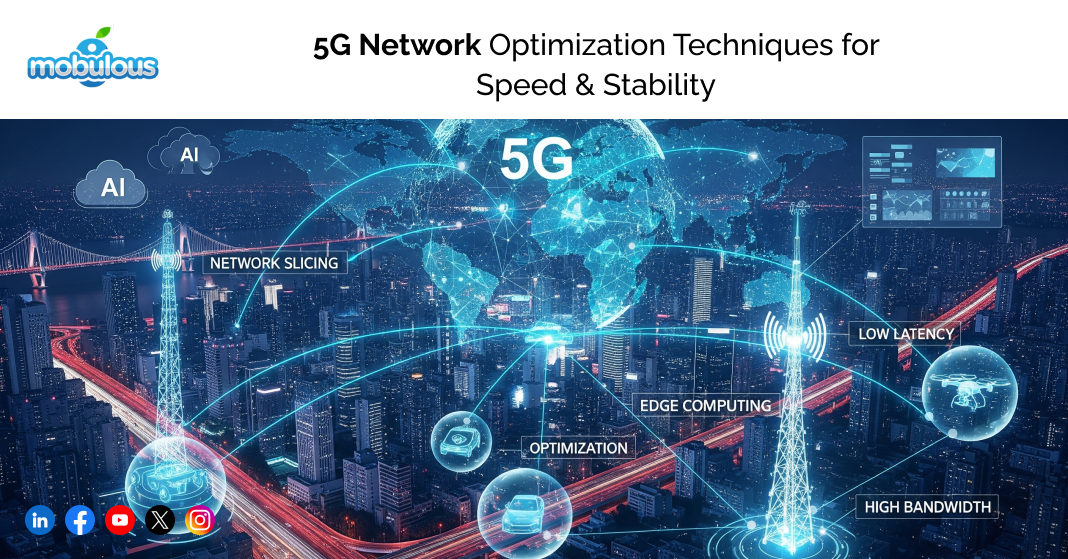What is 5G Network Optimization?
5G network optimization is about improving how 5G networks perform. It involves smart techniques like beamforming, AI-based analysis, and dynamic allocation of resources. The goal is to make sure networks stay fast, efficient, and responsive. It ensures reliable service even when many users are connected simultaneously.
For businesses looking to enhance their network capabilities, partnering with a trusted telecom software development company can provide tailored solutions to maximize 5G performance.
List of Top 5 5G Network Optimization
- Beamforming and Massive MIMO
- Network Slicing
- AI-powered Optimization
- TCP Optimization
- Load Balancing
Read more: Enterprise Mobile App Development and 5G’s Impact: A Look Ahead to 2025.
Top 5G Network Optimization Techniques: Benefits & Examples
1. Beamforming and Massive MIMO
Beamforming and Massive MIMO are key tools in 5G network optimization. They make signals more focused and efficient. This means users get stronger, more reliable connections. These techniques are especially useful in busy areas. They let networks handle lots of users at once without slowing down.
How it Works:
Beamforming directs signals straight toward a user’s device instead of sending them everywhere. It’s like using a flashlight to direct light rather than a light bulb that spreads it everywhere. Massive MIMO adds a large number of antennas to towers. This allows them to serve more devices at the same time with better quality.
Benefits of this 5G Network Optimization:
- Better Signal Quality
- Higher Capacity
- Improved Data Speeds
Real-world Example
Verizon 5G Ultra Wideband: Verizon uses beamforming and Massive MIMO in major U.S. cities. Places like stadiums and airports stay connected, even during large events. Users enjoy fast speeds with minimal lag in dense environments.
2. Network Slicing
Network slicing is a powerful 5G network optimization method. It divides a physical network into multiple virtual ones. Each slice serves a specific use case. This allows different services to run smoothly on the same infrastructure. It’s efficient and cost-effective.
How it Works:
The network is split into virtual layers. Each layer gets its own set of rules and priorities. A factory robot, for example, uses a different slice than someone streaming a movie. These slices don’t interfere with each other. This keeps services fast and reliable.
Benefits of this 5G Network Optimization:
- Customization
- Efficiency
- Security
Real-world Example
SK Telecom in South Korea: SK Telecom uses network slicing in smart factories. Each robot and sensor runs on its own dedicated slice. This prevents interference and keeps operations smooth. The system boosts safety and speed in automated environments.
3. AI-powered Optimization
AI-powered optimization brings intelligence to 5G network optimization. It helps networks adjust themselves automatically. AI monitors conditions, predicts issues, and reacts fast. This keeps the network running efficiently. It also reduces the need for manual fixes.
How it Works:
AI systems analyze traffic in real time. They find patterns and detect problems early. If traffic gets heavy, AI shifts resources before delays happen. This is like having a smart traffic light system for data. Everything keeps moving without jams.
Benefits of this 5G Network Optimization:
- Proactive Maintenance
- Improved User Experience
- Energy Efficiency
Real-world Example
Vodafone’s AI-based SON: Vodafone uses AI to manage its 5G systems in Europe. The AI makes changes on its own. It balances loads, fixes errors, and improves performance. Users see fewer drops and smoother connections.
4. TCP Optimization
TCP optimization fine-tunes how data moves through the network. It’s crucial for maintaining 5G’s high speeds. Without it, old data-handling methods slow everything down. This upgrade helps keep downloads fast and video calls stable.
How it Works:
TCP controls how data packets travel. In 5G, changes are made to speed things up. This involves faster acknowledgments and fewer retransmissions, improving data efficiency. The system becomes smarter at handling delays and congestion. Data flows faster and more reliably.
Benefits of this 5G Network Optimization:
- Reduced Latency
- Higher Throughput
- Stability in Mobility
Real-world Example
Ericsson’s TCP Acceleration Platform: Ericsson added TCP optimizations for carriers worldwide. It boosts speeds and reduces video buffering. The system adapts well to changing conditions like movement and congestion.
5. Load Balancing
Load balancing helps networks stay smooth and stable. It spreads traffic across towers and servers. When one part gets crowded, traffic shifts elsewhere. This keeps everything running fast and evenly. It’s a must for any high-traffic environment.
How it Works:
Systems monitor real-time usage. If one tower or server gets overloaded, the traffic is redirected. This prevents slowdowns and failures. The process is automatic. It works 24/7 to keep networks steady.
Benefits of this 5G Network Optimization:
- Consistent Performance
- Improved Resource Usage
- Lower Downtime Risk
Real-world Example
AT&T’s Dynamic Load Balancing: AT&T uses this in big cities. It helps users during concerts, rush hour, or sports games. Everyone gets a stable signal, even when thousands are online.
Challenges in 5G Networks
1. Infrastructure Costs
5G rollouts need new towers, fiber cables, and power upgrades. These upgrades are expensive. Urban areas usually get them first. Rural zones fall behind due to lower returns and higher costs. These costs delay full-scale coverage, especially in less populated regions.
2. Cybersecurity Risks
More devices mean more attack points. 5G connects everything—from phones to smart factories. Each connection can be a risk. Hackers can target weak points. Protecting this huge network requires constant updates and smart defense systems.
3. Regulatory Hurdles
Governments control 5G spectrum. Rules vary by country and even region. Getting permits, clearing frequencies, and aligning standards take time. These delays make the global rollout harder. Carriers must navigate complex red tape to expand.
4. Coverage Gaps
5G uses high frequencies that don’t travel far. Cities get small cells everywhere. Rural areas don’t. That leaves big gaps. Without enough towers, users miss out on true 5G speeds. Coverage is patchy outside urban zones.
Read more: Enterprise Mobile App Development Trends (IoT, Blockchain, 5G).
Conclusion
5G is more than just a faster internet. It’s the foundation for smarter and more responsive digital experiences. But to unlock its full potential, it needs constant optimization.
Techniques like beamforming, network slicing, AI analytics, and load balancing help keep the network fast and stable. These tools make sure 5G can handle the growing demand and complex use cases.
From factory automation to smooth video streaming, optimization turns 5G from potential into real performance. As more devices connect, the network must stay smart and efficient. Continuous improvement is the key to making that happen.
FAQs – Top 5G Network Optimization
Q1. What is 5G optimization?
5G optimization is the process of improving how 5G networks work. It includes tools like beamforming, slicing, and AI to boost performance. The goal is to reduce delays, increase speed, and support more devices. It ensures smooth service for all kinds of users and applications.
Q2. How do you optimize a 5G connection?
Start with a 5G-compatible device. Keep software updated. Use a 5G signal booster if needed. Place your router away from other electronics. Check for interference and adjust your settings. These steps help you get better speed, stability, and a stronger signal from your 5G network.
Q3. How does 5G improve connectivity?
5G boosts speed, lowers latency, and supports more devices. It makes apps faster and video smoother. Devices connect without delays. You can stream, game, or use smart tools with fewer interruptions. This creates a better and more stable online experience for everyone.
Q4. How to boost the 5G signal?
Move closer to a 5G tower or an open area. Use a 5G signal booster for stronger coverage. Keep your device updated. Reduce interference by moving away from electronics. Try different locations in your home or office. These actions help you get a better signal.
Q5. Is LTE better than 5G?
No, 5G is faster and more advanced than LTE. It offers lower latency and can connect more devices at once. LTE is still reliable, especially where 5G is not available. But 5G is built for the future. It handles everything from smart homes to high-speed streaming.
Q6. What are the 5G optimization techniques?
Key techniques include beamforming, massive MIMO, and AI-powered control. Network slicing allows custom services. TCP optimization improves data transfer. Load balancing spreads traffic to avoid overload. These methods work together to keep 5G networks fast, efficient, and reliable for users everywhere.
































